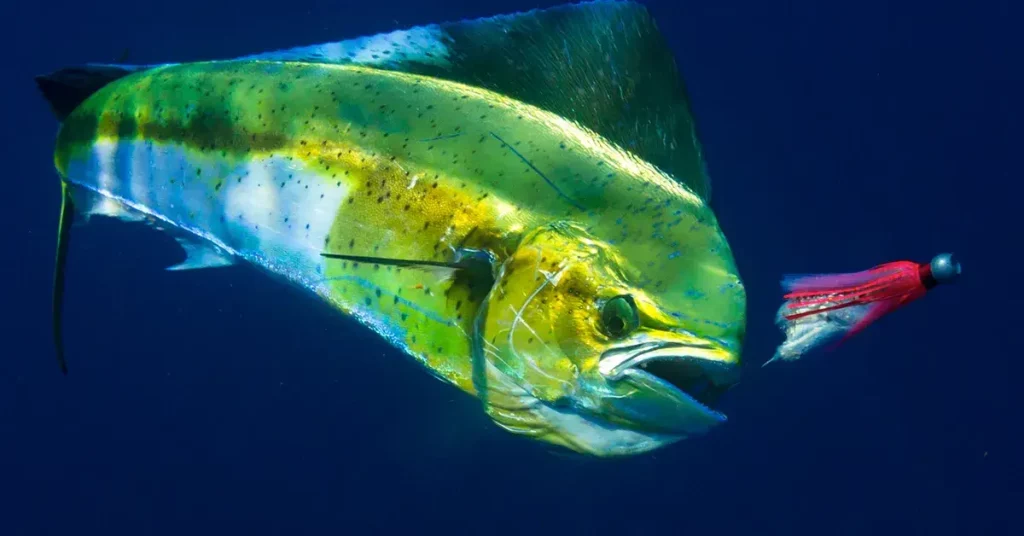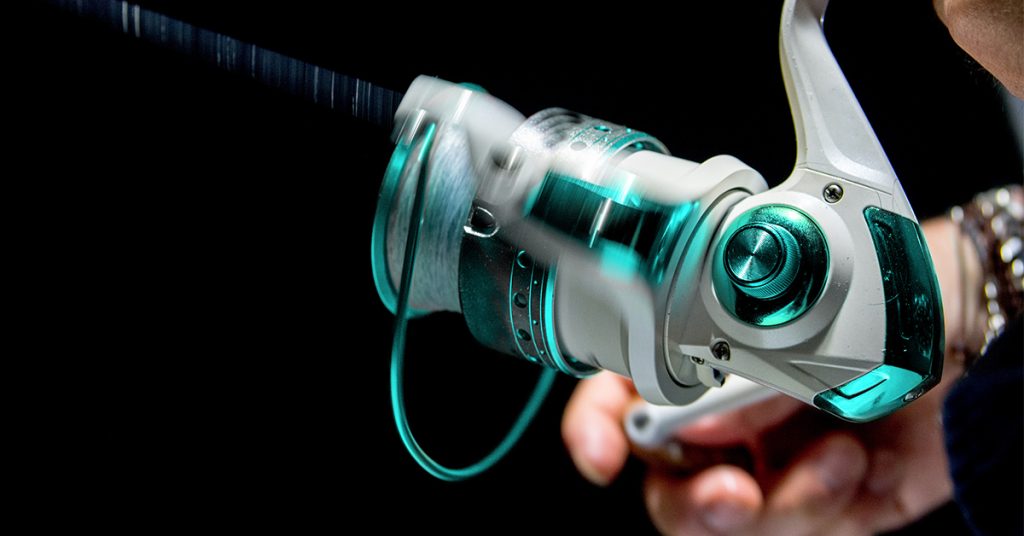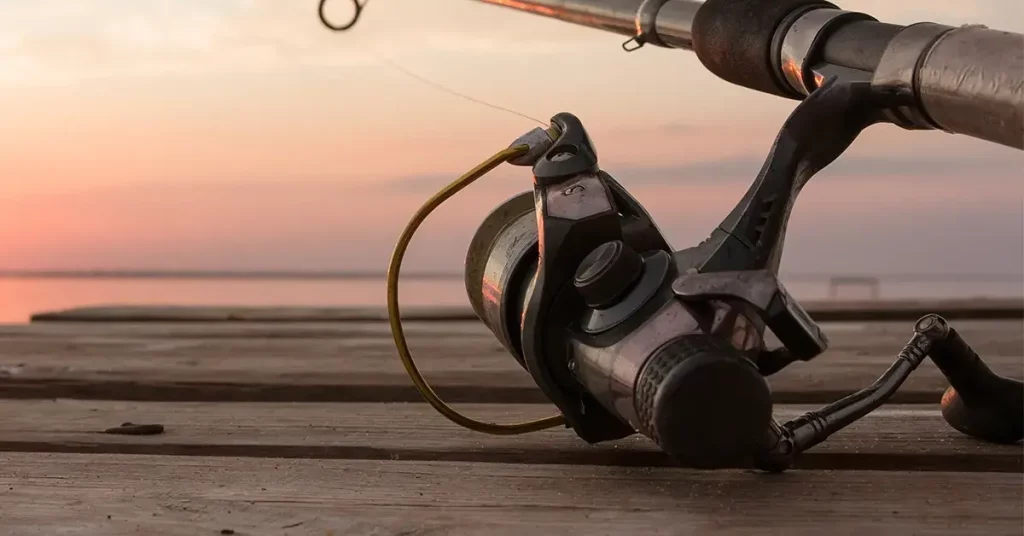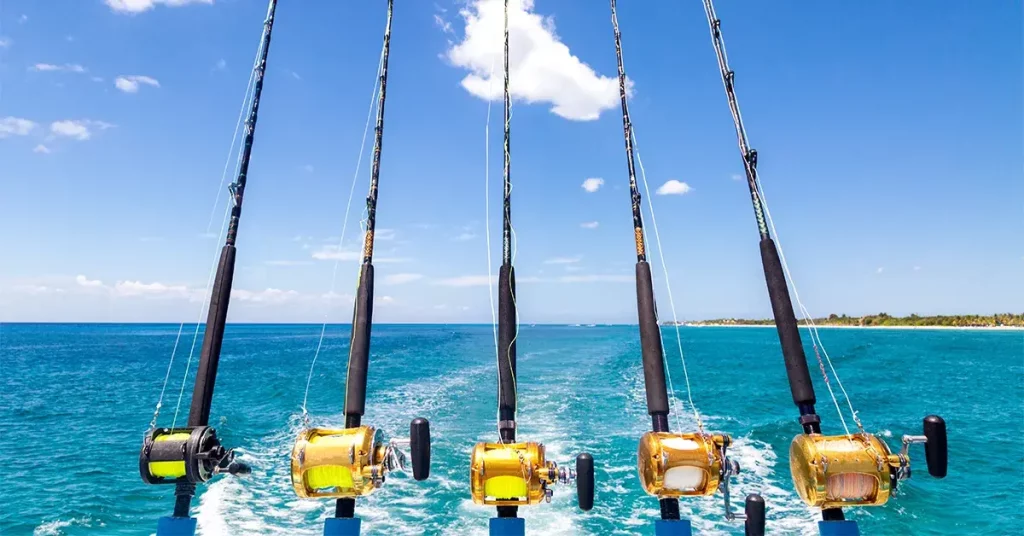Dorado fish are one of the most highly sought-after saltwater species – owing to their tasty meat, impressive size, stunning beauty, and healthy population. They can be found all around the world, in temperate, subtropical, and tropical waters around the globe.
Dorado fish go by many different names, including Mahi-Mahi, dolphin fish, Coryphaena Hippurus or simply dorado. The name dorado comes from the Spanish word for golden – referring to their brilliant yellow-gold colored flanks. The name Mahi-Mahi comes from the Hawaiian word for “very strong”.
Dorado are sometimes confused with another similarly named fish – the golden dorado. However, this freshwater species found in Central and South America is completely unrelated to the Dorado.
Let’s take a look at some of the key Dorado fish characteristics, how to catch them, what gear you’ll need, as well as how to cook and clean these tasty beauties.
Dorado Fish Facts
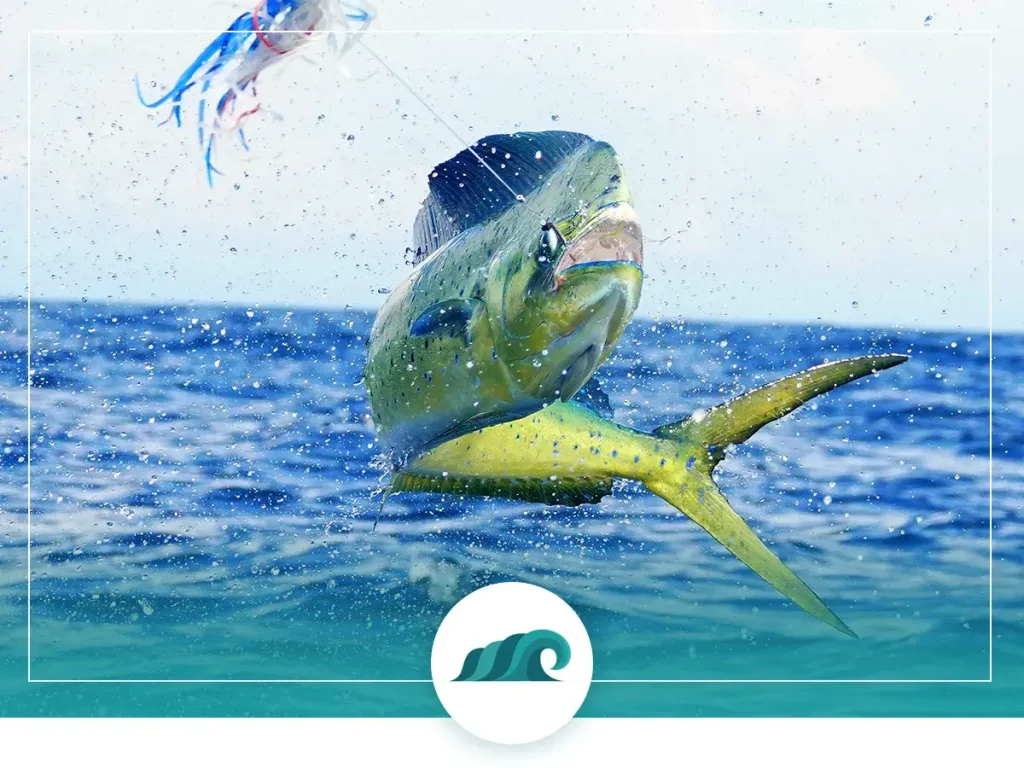
Mahi-Mahi are distinctive looking fish – with long compressed bodies and single dorsal fin running the length of their backs, nearly from head to tail. Their most unique feature might be their prominent foreheads that protrude well above their bodies.
They’re vibrantly colored fish, with brilliant blue and green backs and sides, and dazzling gold-colored flanks. When they’re out of the water, they go through several color changes before fading to greyish yellow upon death.
They can live up to five years long, although most won’t live much longer than four. Most dorado are between 15 and 30 pounds (7 to 13 kg) when they’re caught, although they can grow up to 50 lbs (23kg) in some cases.
They’re opportunistic eaters and will eat nearly anytime of baitfish in the ocean. They feed primarily on ballyhoo, flying fish, squid, mackerel, crabs, and other forage fish. They can usually be found feeding in schools or in pairs near the surface.
Dorado Fish Range & Habitat
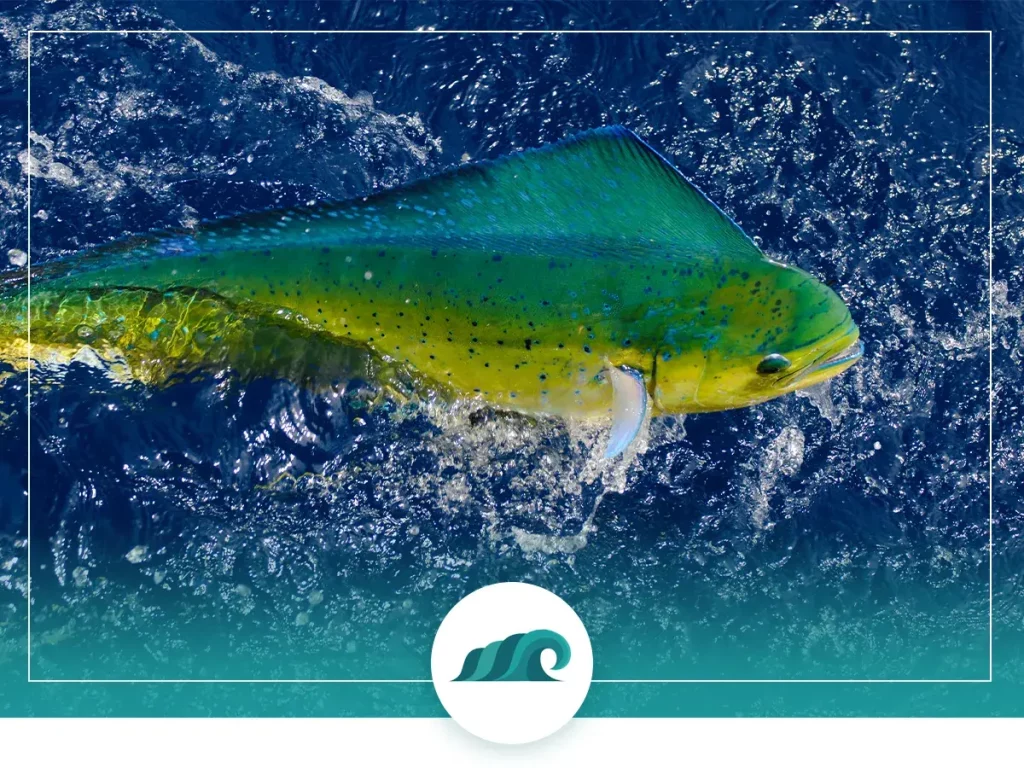
Dorado are widely distributed throughout temperate, subtropical, and tropical waters around the globe. They display nomadic behavior, which makes them fairly resistant to fishing pressures. Many swim an average of 25 miles per day and they generally don’t stay in one place for long.
Dorado can be found in abundance throughout the Caribbean, along the west coast of North and South America, the Gulf of Mexico, the Atlantic coast of Florida, Hawaii, as well as many other places.
They feed mostly on the surface, down to about 120 feet deep. They’ve also been known to feed deeper in the water column – especially larger bull males. They can often be found near floating piles of debris, seaweed mats, kelp patties, and buoys feeding on the smaller fish taking shelter there. Frigatebirds are another good indicator that dorado may be in the area.
How to Catch Dorado Fish?
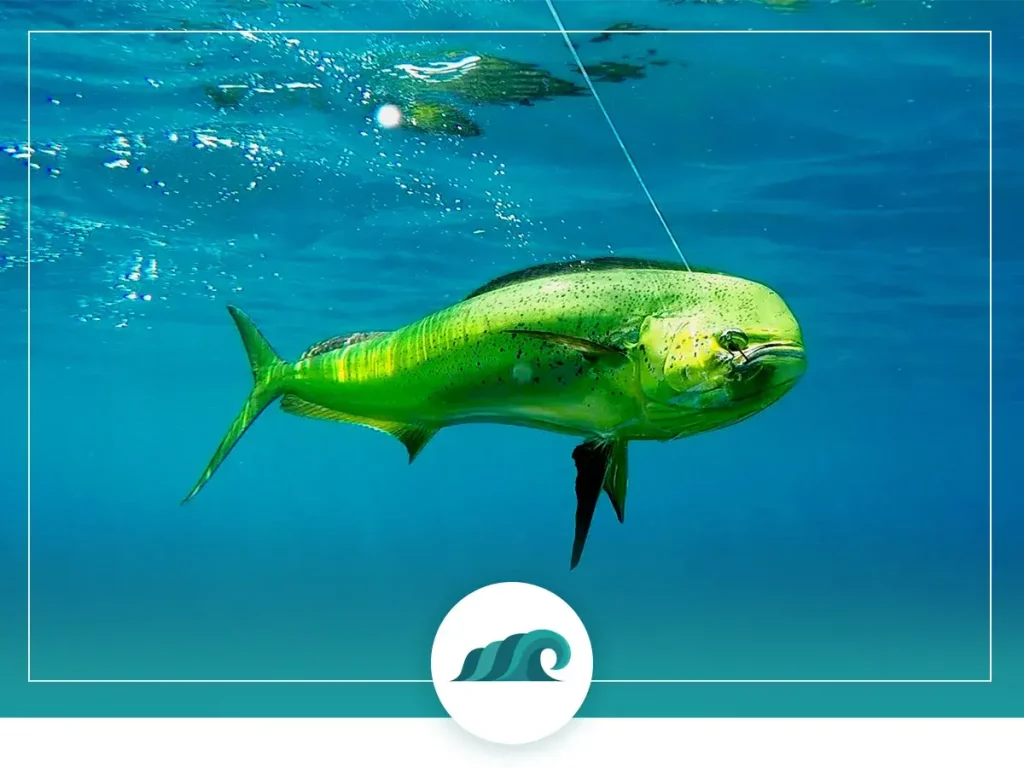
Dorado fish can be caught with several different techniques – but the most popular method by far is by trolling. As they’re often on the move, trolling gives you the best chance of a successful hookup.
Mahi behavior changes depending on their size and level of maturity. Smaller, younger fish will often form large schools to protect themselves from predators. These fish are usually found at or near the surface and are less challenging to catch than their larger counterparts.
As the fish grow these schools shrink, and the fish start hanging deeper in the water. Larger Mahi are more cautious than smaller ones, so you may need to entice them by chumming the water to get a bite from them.
As mentioned previously, the best strategy for locating dorado is to look for floating piles of kelp or seaweed with seabirds nearby. A boat with a high tower and a good pair of binoculars can help with this. Once you’ve located a promising spot, approach slowly with several baited lines in the water behind you. You’ll want to go slow, as too much noise can scare them off.
Dorado Fishing Tactics
To get a bit more specific, let’s take a look at some of the region-specific techniques used to catch these golden torpedos!
Florida is one of the most popular Mahi fishing destinations’ in the world, and hosts several international tournaments focused on catching dorado. Spring and summer are the most popular times for catching Mahi, usually from April to about September.
They’re typically caught by trolling baits and lures (ballyhoo is popular), with live baits like working well when the fish are acting finicky. Unlike fishing for tuna, full spreader bars aren’t necessary to attract the fish while trolling. Limiting the number of lines in the water will prevent entanglement with weed lines, and allow you to rebait hooks quickly when you start catching fish.
Once a Mahi takes your bait, give it a two Mississippi count and let the fish free-spool, then put the reel in gear and the set the hook with authority. You don’t want to wait for the Mahi to set the hook – as they’re notorious for spitting out bait when they feel a hook.
One effective technique is to leave a smaller hooked Mahi in the water when you hit a school. This will keep the rest of the school following you and can help entice larger fish to take your bait.
Southern California is another popular Mahi fishing spot, with the fish migrating north from Mexico during the summer months. They tend to be somewhat finicky when it comes to lures and dead baits, so be sure to bring along some live bait like mackerel or sardines.
Similar to Florida-style Mahi fishing, you’ll want to locate a kelp patty, and then slow troll several staggered lines going back about 50 feet behind the boat. Make several passes or circle the patty to entice a bite. If you see Mahi in the water but you aren’t getting a bite, throw chunks of cut bait into the water to get them warmed up.
Mahi-Mahi Fishing Gear
So, what do you need to start catching Dorado?
While a lot of fishing charters will use the same heavy-duty gear that they use for targeting larger offshore species, going with lighter tackle will give you the finesse needed to catch these speedy fish. Plus, this will allow you to feel a Mahi grab your bait, take off, and get airborne! Tuna rods and reels will definitely still catch Mahi, but won’t give you as good of a fight.
If you’re trolling, a fast and sturdy star-drag reel like the Daiwa Saltist is the way to go. Size 40 or 50 will give you enough power to tackle larger bull Mahi. Pair that with a 7 to 8-foot-long light-action rod and you’ve got a killer Mahi rig. Use 20 pound fused or braided line like Berkley Fireline, attached to a heavy-duty 3-foot fluorocarbon leader.
If you’re looking for a spinning setup to throw baits and jigs, the Penn Battle II 5000 or similar reels will give you enough speed and power to tackle any sized dorado. Pair your reel up with a 7-foot spinning rod like the Uglystick Bigwater Spinning Rod and you’ve got yourself a versatile dolphin fishing rig.
Lures and Bait
As mentioned previously, Mahi generally aren’t that picky when it comes to baits and lures, but there are a few things to keep in mind when selecting the right bait presentation.
Ballyhoo, mackerel, sardines, blue runners, pilchards or other native baitfish make excellent bait for catching Mahi, and when rigged correctly the fish won’t notice the hook until it’s too late. Simply take a size 4/0 to 6/0 hook and hook it under the chine of the fish, so the hook faces downwards. You can also add a rubber skirt to further entice the Mahi, and prevent the bait from washing out.
Don’t be afraid to go large, as Mahi aren’t shy and will go after 8”+ bait with gusto. Both live and dead bait work well, but if you’re using dead bait try to keep it as fresh and natural-looking as possible.
Check out this excellent video for a hands-on look at how to rig ballyhoo:
As far as lures go, colorful skirted rubber lures are extremely effective, with squid, flying fish, and ballyhoo shaped lures being popular. These lures will also work well for trolling other larger saltwater species like wahoo, tuna, sailfish, and smaller Marlin.
Check out these proven lures for an effective way to start catching Mahi:
- Ballyhoo Lure: 12-Inch BallyBay
- Set of 6 Lures: kmucutie Set of 6 pcs 9-inch Trolling Skirt Lures
- Squid Lure: Mahi Morsel
- Flying Fish Lure: OCEAN CAT 5 Pcs Flying Fish
- Jigs: Ahi USA Ahi Assault Diamond Jigs
Dolphin Fishing Tips
How can you catch more Dolphin fish?
Following the techniques and tactics described above will help you catch Mahi, but let’s take a look at some specific tips you can implement to increase your success rate.
- Stagger your lines. Rather than trolling with your lines fixed at the same distance behind your boat, staggering them will better mimic the behavior of baitfish – increasing your odds of a bite. Lures will also behave differently depending on interference from your boat’s wake, so make sure to experiment and see what works best.
- Trolling speed. The right trolling speed will have a major impact on how your lures behave. Finding the right speed can take a little trial and error – too fast and your lure will skip across the surface, too slow and it will sink like a stone. Speeds between 10 and 15 knots typically work well. This is especially important when using lures designed to create a mini bubble-wake behind them. This bubble trail will mimic the behavior of real baitfish, and attract the Mahi like a moth to a flame.
- Utilize multiple setups. While trolling is the most popular way of catching Dorado, you should also bring spinning and jigging setups along. This will enable you to throw poppers, jig, and cast right off the edge of a weedline.
- Chum the Water. One of the best ways to hook Mahi is to throw chopped bait into the water. This will get them to start feeding on your bait, and then you throw a hooked piece of bait in the water – which they’ll happily wolf down.
- Pre-rig baits. Keep pre-rigged baits on ice, so you can quickly swap out your bait once it gets destroyed. When you’re on top of a school, Mahi fishing can get pretty hectic, and you don’t want to waste precious time fiddling around with bait.
Spearfishing for Dorado
Spearfishing for Mahi is an increasingly popular way of catching these speedy predators. You’ll often see anglers donning dive gear and grabbing spearguns or pole spears and jumping in the water when they’re on top of a school.
Spearfishing for Mahi uses many of the same techniques as rod and reel fishing. To get started, you’ll want to locate a healthy-looking patty of kelp or sargassum. Patties with seabirds around them are an even better indicator that baitfish – and possibly Mahi – are in the water.
If you spot Mahi, chum the water with pieces of cut bait to avoid scaring them off and help keep them in the area. As Mahi can get fairly large and powerful, you’ll want to use floatline and dive float to avoid losing your gun.
One of the nice things about spearfishing for dorado is that you can choose which fish to go after. Targeting that monster bull is much easier with a speargun than it is with a rod and reel.
Check out this video for an exciting look at spearfishing for Dorado:
How to Clean Dorado
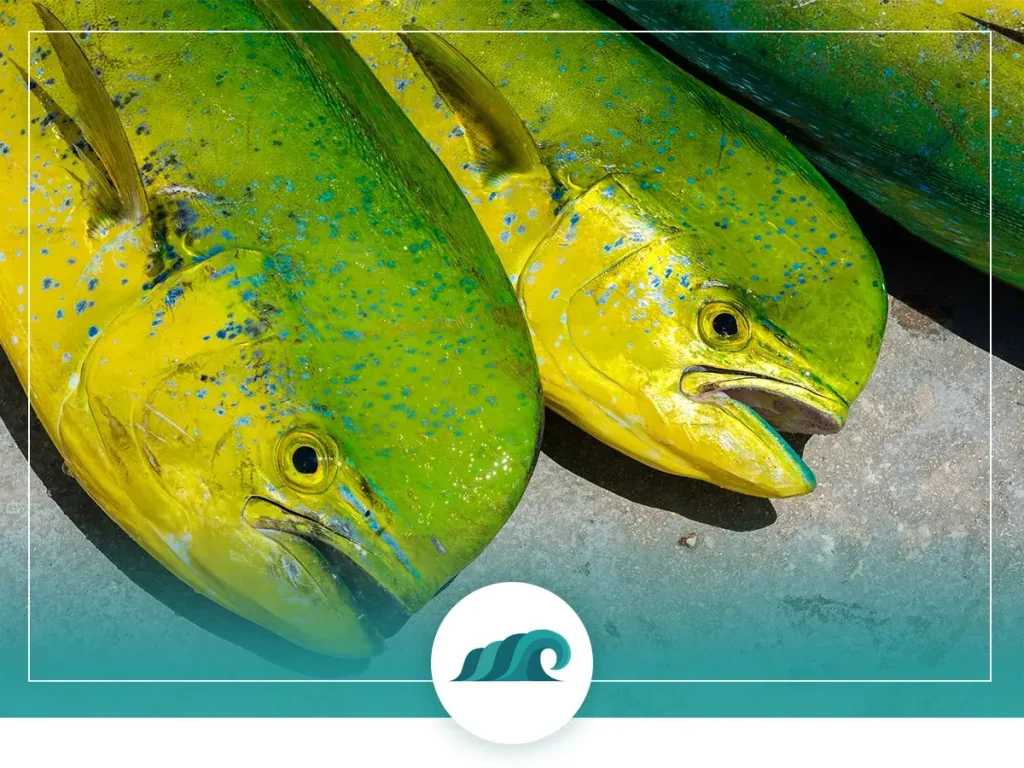
Once you’ve got that beautiful Mahi in the boat, the next thing you’ll need to do is get it cleaned up and ready to eat. Let’s take a look at how to clean and fillet Mahi step-by-step:
- Take your fillet knife and start cutting right behind the gills as you would with any fish.
- Because Mahi have such prominent foreheads, there’s a lot of extra meat located in the head. Drag your knife along the forehead, above the eye, right to the tip of the forehead.
- Now drag the blade along the back, until you reach the tail.
- Use your knife to make clean, shallow cuts from the tail to the head. You’ll feel the knife scrape up against the rib cage and backbone – try to cut as close to the bones as possible.
- Cut through to the fish’s belly and remove the fillet from the carcass.
- Repeat the process on the other side of the fish.
- Lays the fillets down and remove the skin by dragging your knife between the meat and skin from one end to the other.
- If it’s a large Mahi, you can cut the fillets into serving size steaks.
Mahi Mahi Recipes
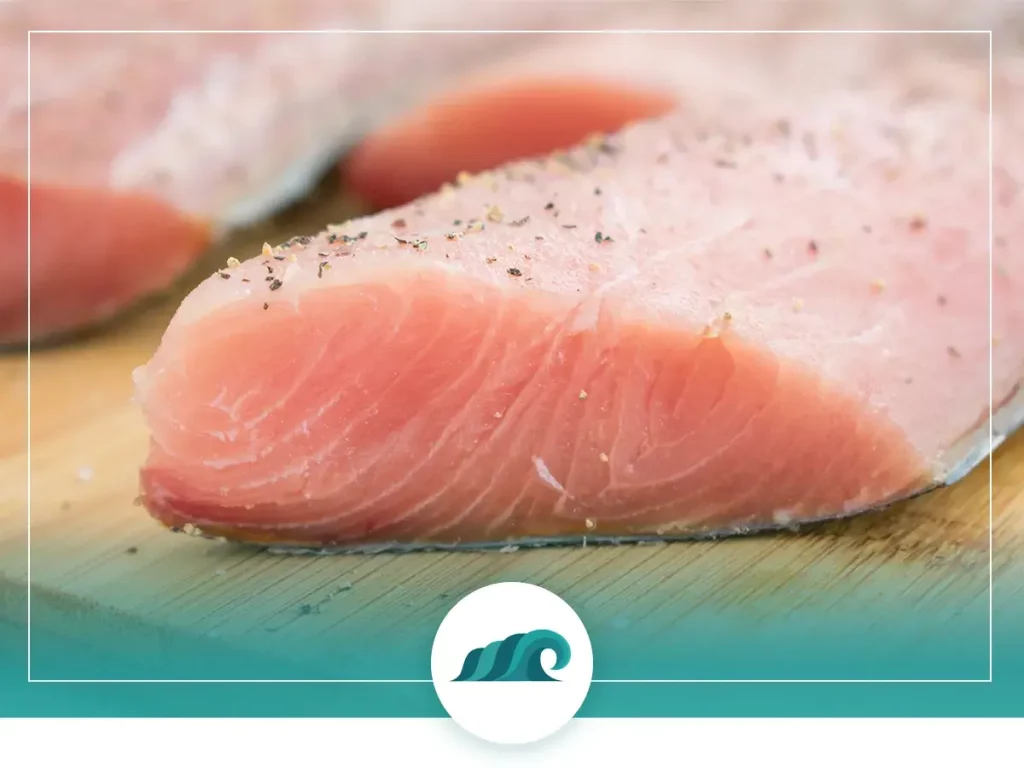
For my money, Mahi are one of the tastiest saltwater fish on the planet. The texture is firm and holds up well to a variety of cooking methods.
They can be pan-fried, sautéed, breaded, baked, or grilled – all with excellent results. Let’s take a look at a few of the best methods to prepare Dolphin fish.
Lemon-Garlic Pan Seared Mahi
Classic lemon-garlic pan-seared Mahi might be the best way to enjoy this fish. It’s simple and straightforward and highlights the tender, delicate flavors.
Ingredients:
- 4 tablespoons unsalted butter
- 4 x 4 to 6-ounce skinless Mahi fillets
- Salt and pepper
- 4 garlic cloves, minced
- 1 lemon cut into slices
- Zest and juice from 1 lemon
- Red pepper flakes
- 2 tablespoons chopped herbs (parsley, cilantro, or chervil)
How to Make it:
- Pat the Mahi filets dry and season with salt, pepper, and red pepper flakes.
- Heat 2 tablespoons butter in a pan over medium-high heat and drop in the fillets.
- Cook until golden brown, around 3 to 5 minutes per side. Remove fillets from pan.
- Add remaining butter, garlic, lemon juice, and zest and half the chopped herbs. Stir for 1 – 2 minutes.
- Spoon pan sauce over Mahi fillets, and serve with remaining chopped herbs.
Marinated Grilled Mahi
Grilling Mahi-Mahi is another great cooking method – and is a guaranteed crowd-pleaser. Marinating the fillets before grilling keeps them moist and adds an extra level of flavor.
Ingredients:
- 4 x 4 to 6-ounce Mahi steaks
- Juice from one lime
- 1 tablespoon high-quality olive oil
- ½ teaspoon salt
- ½ teaspoon fresh ground pepper
How to Make it:
- Combine all the ingredients into a glass bowl and marinate the fish for 15 to 20 minutes. You don’t want to go much longer than that as the lime can start breaking down the fish excessively.
- Grill the fillets over coals or a grill for approximately 5 to 6 minutes per side. This will somewhat depend on the heat level – you’ll know the meat is ready when it’s solid white throughout.
- Take the steaks off the grill and rest for 5 minutes or so.
- Serve with a vibrant fresh salsa and sliced avocado.
FAQ’s
Q: What is Mahi Mahi fish?
A: Mahi Mahi (Coryphaena hippurus) are a surface-dwelling ray-finned fish that dwell in temperate, tropical, and subtropical waters worldwide. They’re a highly sought after game fish with striking colors and fast acrobatic activity.
Q: Are Mahi Mahi endangered?
A: Mahi are not endangered. They’re classified as “least concern” by the IUCN. The population levels are abundant and currently above target levels.
Q: Can Mahi Mahi be eaten rare?
A: Mahi are not generally eaten rare or raw (as in sashimi). The meat lends itself to cooking through until it’s white and flaky. If your set on eating it raw, make sure to bleed the fish right after killing and flash freeze for at least 24 hours.
Q: What does Mahi Mahi taste like?
A: Mahi Mahi is mild and sweet-tasting, with a lean, moist and flaky texture when cooked. The skin is thick and should be removed before cooking.
Q: When is Dorado fishing season?
A: As they are nomadic fish, and move from one location to another, Dorado fishing season varies depending on your location. In Florida, the high season is generally from April to August, although they can be caught year-round. In Southern California, Dorado tend to migrate north in late summer, from the middle of July to August.

